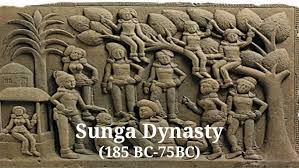Shungas
The Sunga Empire (or Shunga Empire) is a Magadha dynasty that controlled North-central and Eastern India as well as parts of the northwest (now Pakistan) from around 185 to 73 B.C.E. It was established after the fall of the Indian Mauryan empire. The capital of the Sungas was Pataliputra. Later kings such as Bhagabhadra also held court at Vidisa, modern Besnagar in Eastern Malwa. The Sunga Empire is noted for its numerous wars with both foreign and indigenous powers although several kings patronized Buddhism. The Mathura school of art and the works of Patanjali colored North India during this empire. It was replaced by the Kanva dynasty.
Foundation of dynasty
The Sunga dynasty was established in 185 B.C.E., about 50 years after Ashoka’s death, when the king Brhadrata, the last of the Mauryan rulers, was assassinated by the then commander-in-chief of the Mauryan armed forces, Pusyamitra Sunga (“Pusyamitra is said in the Puranas to have been the senānī or army-commander of the
last Maurya king Brhadratha”) while he was taking the Guard of Honor of his forces. Pusyamitra Sunga then ascended the throne.Pushyamitra Sunga became the ruler of the Magadha and neighboring territories. The kingdom of Pushyamitra was extended up to Narmada in the south, and controlled Jalandhar and Sialkot in the Punjab in the north-western regions, and the city of Ujjain in central India. The Kabul Valley and much of the Punjab passed into the hands of the Indo-Greeks and the Deccan to the Satavahanas. Pushyamitra died after ruling for 36 years (187-151 B.C.E.). He was succeeded by son Agnimitra. This prince is the hero of a famous drama by one of India’s greatest playwrights, Kalidasa. Agnimitra was viceroy of Vidisha when the story takes place. The power of the Sungas gradually weakened. It is said that there were ten Sunga kings. The Sungas were succeeded by the Kanva dynasty around 73 B.C.E.
Wars and conflicts during sungas
War and conflict characterized the Sunga period. They are known to have warred with the Kalingas, Satavahanas, the Indo-Greeks, and possibly the Panchalas and Mathuras. The Sunga Empire’s wars with the Indo-Greek Kingdom figure greatly in the history of this period. From around 180 B.C.E. the Greco-Bactrian ruler Demetrius, conquered the Kabul Valley and is theorized to have advanced into the trans-Indus. The Indo Greek Menander is credited with either joining or leading a campaign to Pataliputra with other Indian Kings; however, very little is know about the exact nature and success of the campaign. The net result of these wars remains uncertain.
Pushyamitra is recorded to have performed two Ashvamedha Yagnas and Sunga imperial inscriptions have extended as far as Jalandhar. Scriptures such as the Divyavadhana note that his rule extended even farther
to Sialkot, in the Punjab. Moreover, if it was lost, Mathura was regained by the Sungas around 100 B.C.E. (or by other indigenous rulers: The Arjunayanas (area of Mathura) and Yaudheyas mention military victories on their coins (“Victory of the Arjunayanas,” “Victory of the Yaudheyas”), and during the first century B.C.E., the Trigartas, Audumbaras and finally the Kunindas also started to mint their own coins). Accounts of battles between the Greeks and the Sunga in Northwestern India are also found in the Mālavikāgnimitram, a play by Kālidāsa which describes a battle between Greek cavalrymen and Vasumitra, the grandson of Pushyamitra, on the Indus river, in which the Indians defeated the Greeks and Pushyamitra successfully completed the Ashvamedha Yagna.Nevertheless, very little can be said with great certainty. However, what does appear clear is that the two realms appeared to have established normalized diplomatic relations in the succeeding reigns of their respective rulers. The Indo-Greeks and the Sungas seem to have reconciled and exchanged diplomatic missions around 110 B.C.E., as indicated by the Heliodorus pillar, which records the dispatch of a Greek ambassador named Heliodorus, from the court of the Indo-Greek king Antialcidas, to the court of the Sunga king Bhagabhadra at the site of Vidisha in central India.
Cultural achievements during sungas
While there is much debate on the religious policies of the Sunga dynasty, it is recognized for a number of contributions. Art, education, philosophy, and other learning flowered during this period. Most notably, Patanjali’s Yoga Sutras and Mahabhasya were composed in this period. It is also noted for its subsequent mention in the Malavikaagnimitra. This work was composed by Kalidasa in the later Gupta period, and romanticized the love of Malavika and King Agnimitra, with a background of court intrigue. Artistry on the subcontinent also progressed with the rise of the Mathura school, which is considered the indigenous counterpart to the more Hellenistic Gandhara school of Afghanistan and Pakistan.
During the historical Sunga period (185 to 73 B.C.E.), Buddhist activity also managed to survive somewhat in central India (Madhya Pradesh) as suggested by some architectural expansions undertaken at the stupas of Sanchi and Barhut, originally started under King Ashoka. It remains uncertain whether these works were due to the weakness of the control of the Sungas in these areas, or a sign of tolerance on their part.
The last of the Sunga kings was Devabhuti (83-73 B.C.E.). He was assassinated by his minister (Vasudeva Kanva) and is said to have been over fond of the company of women. The Sunga dynasty was then replaced by the subsequent Kanvas.
GPSC Notes brings Prelims and Mains programs for GPSC Prelims and GPSC Mains Exam preparation. Various Programs initiated by GPSC Notes are as follows:-
- GPSC Mains 2025 Tests and Notes Program
- GPSC Prelims Exam 2025- Test Series and Notes Program
- GPSC Prelims and Mains 2025 Tests Series and Notes Program
- GPSC Detailed Complete Prelims Notes

